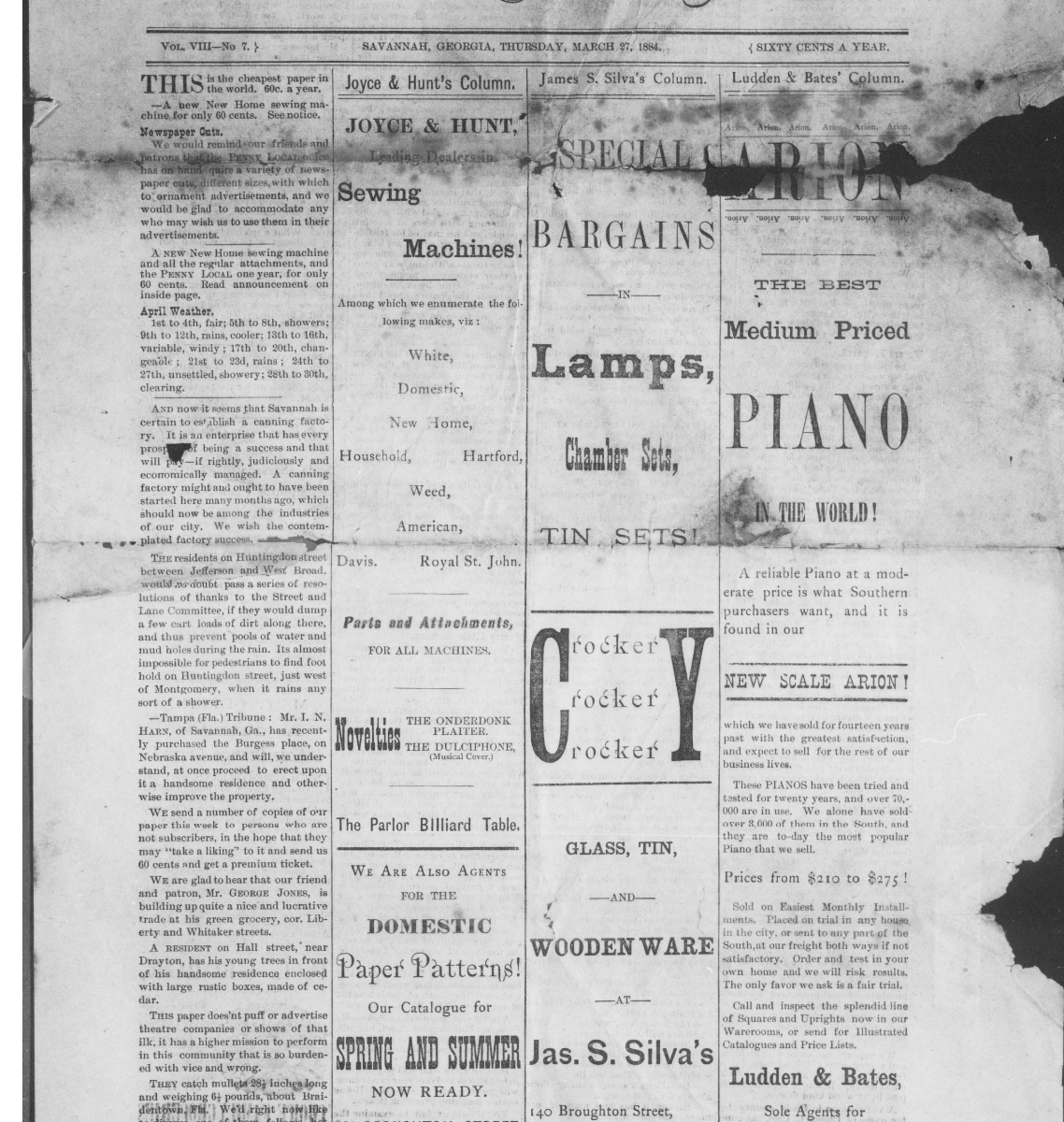This past spring and summer, the Digital Library of Georgia released several new grant-funded newspaper titles to the Georgia Historic Newspapers website. Included below is a list of the newly available titles.
Titles digitized in partnership with the Atlanta History Center
Titles funded by the Chattooga County Historical Society
Titles funded by the De Soto Trail Regional Library System
Titles funded by Farris Cadle
Searchlight (Savannah), 1906-1907
Titles funded by the Forsyth County Government
Forsyth County News (Cumming), 1995-2004
Titles funded by the Georgia Public Library Service, a unit of the Board of Regents of the University System of Georgia, using federal Library Services and Technology Act funds administered through the Institute for Museum and Library Services
Augusta News-Review, 1972-1985
Chattooga News (Summerville), 1888-1896
Dade County Times (Trenton), 1925-1959
Miller County Liberal (Colquitt), 1907-1926
News-Review (Augusta), 1971-1972
Summerville Gazette, 1884-1885
Titles funded by the Georgia Historical Records Advisory Council and the Live Oak Public Libraries
Titles funded by the National Digital Newspaper Program with a grant from the National Endowment for the Humanities
Atlanta Constitution, 1887-1903
Atlanta Semi-Weekly Journal, 1919-1920
Atlanta Tri-Weekly Journal, 1920-1925
Jeffersonian (Atlanta), 1907-1917
Watson’s Weekly Jeffersonian (Atlanta), 1907
Weekly Jeffersonian (Atlanta), 1906-1907
Titles funded by the Roman Catholic Archdiocese of Atlanta
Georgia Bulletin (Atlanta), 1963-1980
Titles funded by the R.J. Taylor, Jr. Foundation in partnership with the Atlanta History Center
Athens Evening Chronicle, 1889
Atlanta Universalist, 1881-1882
Baptist Banner (Atlanta), 1862-1864
Baptist Banner (Cumming), 1880
Baptist Sun (Gainesville), 1889
Banner and Baptist (Atlanta), 1862
Carroll County Times (Carrollton), 1880-1885, 1895
Cherokee Advance (Canton), 1880, 1898
Cherokee Advocate (Marietta), 1848
Cherokee Agriculturist and Patron of Husbandry (Dalton), 1875
Columbia Advertiser (Harlem), 1881-1882
Columbia Sentinel (Harlem), 1886-1887
Columbus Daily Times, 1878-1885
Daily Argus (Dalton), 1910-1911
Daily Chronicle & Sentinel (Augusta), 1850
Daily Evening News (Macon), 1865
Daily Journal and Messenger (Macon), 1865
Daily New Era (Atlanta), 1865-1868
Evening Herald (Atlanta), 1882
Evening Post (Brunswick), 1890
Daily New Era (Atlanta), 1865-1868
Georgia Banner & Sentinel (Newnan), 1861
Georgia Grange (Atlanta), 1873-1877
Georgia Literary and Temperance Crusader (Atlanta), 1861
Georgia Pioneer, and Retrenchment Banner (Cassville), 1835-1839
Georgia Record (Atlanta), 1899-1900
Georgia Statesman (Milledgeville), 1825-1827
Hustler of Rome (Rome), 1894-1898
Independent Blade (Newnan), 1861
Jewish Tribune (Atlanta), 1896
Kind Words for the Sunday School Children (Macon), 1877
Kennesaw Route Gazette (Atlanta), 1875
Landmark Banner & Cherokee Baptist (Atlanta), 1859-1861
Marietta Semi-Weekly Advocate, 1861
Miners Recorder and Spy in the West (Auraria), 1834-1837
Mountain Signal (Dahlonega), 1877-1883
New South (Douglasville), 1891-1906
New Western Railway Guide (Atlanta), 1887
New Working World (Atlanta), 1886
North Georgia Times (Dalton), 1860-1863
North Georgian (Gainesville), 1878-1883
Pilgrim’s Banner (Valdosta), 1895-1897
Progressive Era (Athens), 1899
Republican Herald (Columbus), 1836
Rome Courier and Southern Statesman, 1859
Rome Hustler-Commercial, 1898-1899
Rural Southerner & Plantation (Atlanta), 1875
Semi-Weekly True Flag (Rome), 1861
Soldier’s Friend (Atlanta), 1863
Southern Recorder (Milledgeville), 1846-1855
Southern Statesman (Calhoun), 1855
Southern Whig (Athens), 1834-1839
Southerner and Commercial Advertiser (Rome), 1861
Standard of Union (Milledgeville), 1834-1840
State Press (Macon), 1857-1859
Sun and Columbus Weekly Enquirer, 1874
Weekly Atlanta Intelligencer, 1867-1870
Weekly Augusta Chronicle, 1893-1898
Weekly Constitutionalist (Augusta), 1862-1869
Weekly Republic (Augusta), 1849-1851
Weekly Southerner (Rome), 1861
Weekly Star (Douglasville), 1885-1887
Weekly Tribune (Rome), 1893-1895
Western Herald (Auraria), 1834


